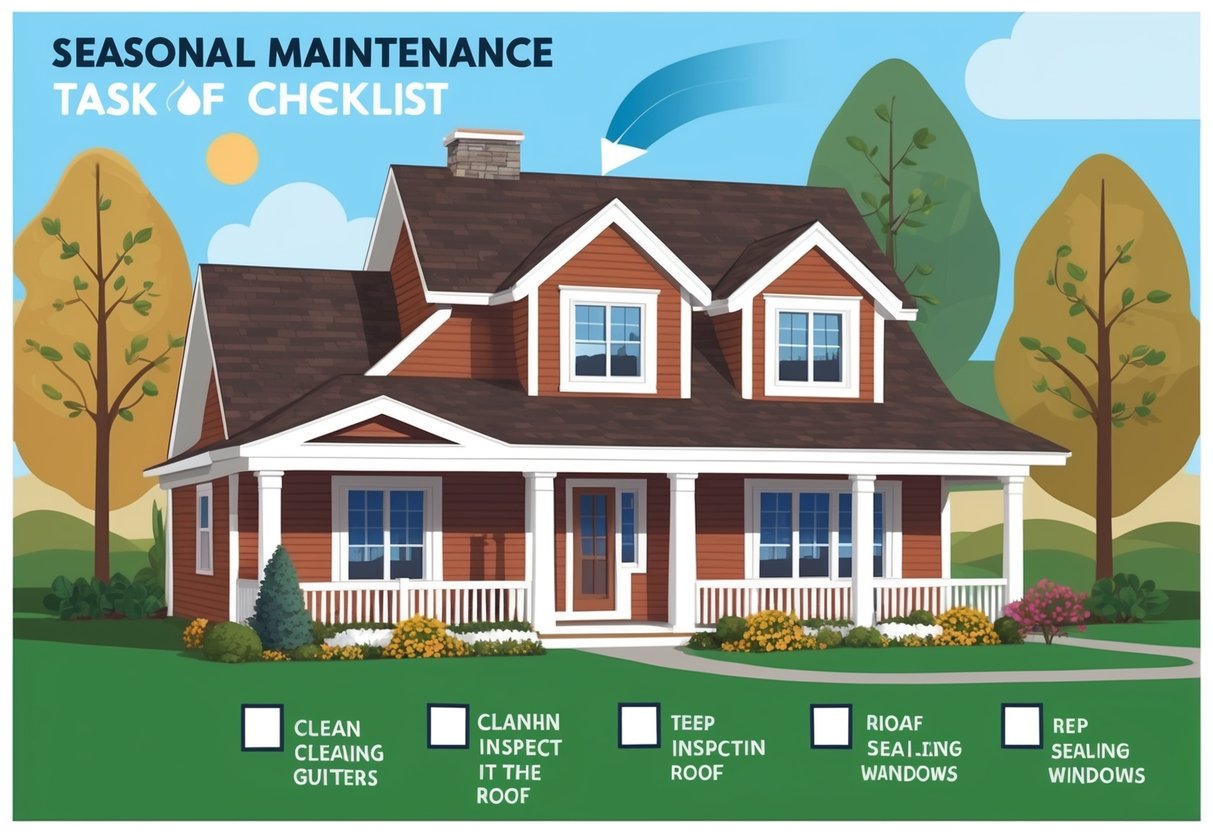
Spring Home Maintenance Essentials
Effective spring home maintenance keeps key systems working well, prevents water damage, and can help avoid expensive emergency repairs. Addressing routine tasks like gutter cleaning, roof inspections, and exterior washing extends the lifespan of a home’s materials and protects property value.
Inspecting and Cleaning Gutters
Clogged gutters can cause significant problems, from water backing up into the roof to damaging the foundation. In early spring, homeowners should remove leaves, twigs, and debris from all gutters and downspouts.
Check that water flows freely to the downspout and that there are no visible signs of sagging or loose sections. It is important to ensure gutters are securely fastened to the house and that attachments have not loosened over winter.
Look for indications of rust, holes, or separations at the seams. Rainwater pouring over the side during a light storm means further gutter cleaning or realignment is needed.
For more on this task, see this spring home maintenance checklist.
Examining Roof for Damage
Spring is a critical time to inspect the roof for any lingering effects of winter weather. Homeowners should visually examine shingles for warping, cracking, or missing pieces.
Special attention should be given to valleys, flashing, and ridge caps as these are common locations for leaks. Check for evidence of moss or algae growth, which can indicate poor drainage and lead to decay.
Inspect attic spaces for signs of water stains, mold growth, or daylight peeking through the roof boards. If roof repair is needed, schedule work before summer storms to prevent unnecessary interior damage.
Some specific steps are also detailed in these tips for a successful season.
Checking Outdoor Faucets and Sprinklers
Winter freeze can crack pipes and hose bibs, so it’s essential to check all outdoor faucets and irrigation systems during spring maintenance. Turn on each faucet and look for leaks, drips, or reduced water pressure.
Make sure hose connections are tight and washers are not dry or cracked. Sprinkler systems should be run through a full cycle.
Inspect all zones for broken or clogged heads and uneven spray patterns. Adjust or replace damaged components so the landscaping receives even coverage.
Repairing leaks promptly saves water and prevents erosion around the foundation, supporting efficient spring home maintenance.
Power Washing Exterior Surfaces
Winter grime and mildew buildup can damage siding, decks, patios, and walkways. Power washing removes dirt, pollen, and algae that can cause long-term wear.
Use a pressure washer set to the appropriate power for your siding or brick to avoid surface damage. Focus on areas that see the most shade or moisture, as these are prone to mold growth.
Pay attention to north-facing walls, patios, driveway surfaces, and fencing. After cleaning, visually inspect for any cracks, peeling paint, or other signs that further maintenance—like resealing or repainting—might be required.
Power washing is an important part of a well-rounded spring home maintenance routine.
HVAC System Care and Efficiency
Routine HVAC care preserves system lifespan, reduces breakdowns, and keeps energy bills in check. Essential tasks like regular inspections, filter changes, and energy audits help homeowners avoid expensive repairs and maintain home comfort.
Scheduling Professional HVAC Service
Arranging for professional HVAC service at least once a year, typically before major seasonal changes, can help identify potential issues before they escalate. Qualified technicians perform comprehensive checks on components such as the air conditioner condenser, furnace, heat exchanger, and thermostat controls.
A typical professional HVAC maintenance appointment includes inspecting refrigerant levels, cleaning evaporator and condenser coils, and checking for worn parts. These services improve air quality, optimize airflow, and help prevent emergency calls during extreme temperatures.
Annual service can extend the HVAC system’s operating life, while ensuring that any small or hidden problems are addressed early. This minimizes surprise breakdowns and helps homeowners better plan for replacements or upgrades.
Changing Air Filters
Replacing air filters regularly—often every 1-3 months, depending on filter type and household factors like pets or allergies—is a critical maintenance step. Clogged or dirty filters force the HVAC system to work harder, raising energy costs and causing unnecessary wear on the blower motor.
A clean filter increases airflow, maintains consistent indoor air quality, and protects sensitive system components from dust and debris. Neglecting this task can lead to problems with the air conditioner or reduced efficiency in heating and cooling operations.
Simple reminders to check and swap filters at the start of each season can prevent costly HVAC repairs. Detailed guides to air filter maintenance suggest noting replacement dates and keeping spare filters on hand for quick changes.
Maximizing Energy Efficiency
Improving the energy efficiency of the HVAC system lowers utility bills and reduces environmental impact. Homeowners should clean vents, seal ductwork leaks, and keep the area around the outdoor compressor clear of debris to promote proper airflow.
Small upgrades such as programmable thermostats or energy-efficient air conditioners deliver steady savings. Insulating attics and weather-stripping doors further reduces the system’s workload by minimizing heat loss or gain.
A routine energy efficiency checklist is a practical way to spot inefficiencies or maintenance needs. Making seasonal adjustments, such as reversing ceiling fan direction and setting thermostats to recommended temperatures, also helps boost comfort while controlling monthly costs.